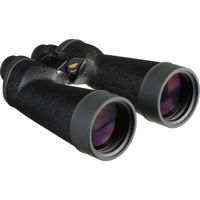
Customers most agreed on the following attributes:
[1 of 1 customers found this review helpful]
Comments about Fujinon Fujinon 16 x 70 FMT-SX Polaris, Water Proof Porro Prism Binocular with 4 Degree Angle of View.:
They are not too heavy or too large; some first-time users complain that they weigh a lot but they are lighter (1900 grams) than the older version (2200 grams). I got used to their girth after a few weeks or regular use. Now the 50mm binos feel skinny in my hands. A 50mm bino is not full-size; it's compact. The full-size are the 63mm and 70mm models.I've spotted nebulae and galaxies that are difficult to see with telescopes much larger than this 70mm aperture. The anti-reflection coatings are perfect: I see no ghosting and the background sky is maximally dark. The toughness of the frame complements the rock-solid stability of the collimation. It has made dozen of trips in my car trunk on bumpy roads and never lost alignment.
They are easy to grip even with gloves because of the pebbled surface; winter observing is easy. They resolve many open clusters in individual stars where smaller, or poorly-made 70mm binos only show a mist with a vague peppering of stars. A guy who tried it immediately commented that it was better than his 80mm bino, and I tried a mid-priced 20x80mm that had poor contrast and less resolution. The hinge and the focus mechanism are firm and smooth; images are sharp over a wide 64° field.
I only wished they had hinged objective lens caps that cannot be lost or forgotten, and the eye relief could be a couple millimeters longer, but just for a bit more comfort because it's long enough to take in the whole view easily.
Overall nothing beats them in 70mm or 80mm aperture.
[0 of 1 customers found this review helpful]
Comments about Fujinon Fujinon 16 x 70 FMT-SX Polaris, Water Proof Porro Prism Binocular with 4 Degree Angle of View.:
When I bought it, I showed it to my father. First thing he asked was, where is the magnification? [he mean zoom]. He was also very surprised that his 8-24x25 Nikon zooms have higher magnification than this, so in his opinion it was stupid of me to buy this large Fujinon binoculars. Nonetheless, I think that my dad's little zoom binos have quite a bit of a tunnel vision compared to these large Fujis. I like the Fujis, my father likes the little Nikon. For each his own, I suppose.
[4 of 4 customers found this review helpful]
Comments about Fujinon Fujinon 16 x 70 FMT-SX Polaris, Water Proof Porro Prism Binocular with 4 Degree Angle of View.:
These are very well made binoculars. Clear bright stars almost to the edge. Far better than my German made binoculars that cost four times as much or other Japanese made at twice as much. Because of the individual focus these are best at viewing things not requiring refocus. These are probably the strongest made binoculars I have but are lighter than I was expecting. Not stylish but I am inspired by the obvious quality. I am sure these will last a lifetime. I have many top rated binoculars and use them several times a day. These Jujinon 16x70 FMT-SX stand out as the best I have ever used for long time observation.
[1 of 5 customers found this review helpful]
Comments about Fujinon Fujinon 16 x 70 FMT-SX Polaris, Water Proof Porro Prism Binocular with 4 Degree Angle of View.:
I used these on my elk hunt and killed the biggest bull of my life. With the rugged terrain where I was hunting, they worked well to spot and stalk.
[6 of 6 customers found this review helpful]
Comments about Fujinon Fujinon 16 x 70 FMT-SX Polaris, Water Proof Porro Prism Binocular with 4 Degree Angle of View.:
I have had them for 4 years and they are still my favorites (I have several other brands/versions). I also have the 7x50 in the same series that are excellent hand held for astronomy...but the 16x70s are my favorites by far for astronomy. Super contrast and resolution with excellent edge performance. They are heavy though so expect to use a mount to hold them steady. I tried the stabilization type binos from Canon and Fuji...too heavy so you really need to put them on a mount too so the stabilization is a moot advantage. The big aperture and optical performance makes these the favorites of many astronomers I know (four of them have the 16x70s). For a really cool setup these work great with a Sky-Window platform (device that uses a front surface mirror to reflect the image and a mount that makes it sort of like looking into a microscope...very comfortable and user friendly.)


